Lakal's Posts
Nairaland Forum / Lakal's Profile / Lakal's Posts
(1) (2) (3) (4) (5) (6) (7) (8) (9) (10) (of 12 pages)
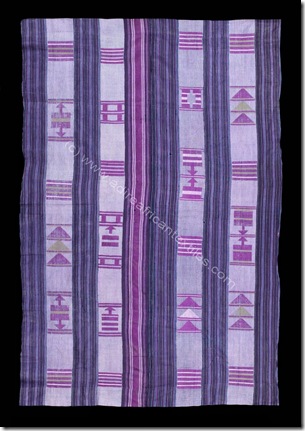 This classic style of nineteenth century Yoruba aso oke cloth involved the alternation of a simple warp striped strip with a second design in which supplementary weft float motifs are laid out on a fine blue and white checked background. In an early example such as this the magenta silk thread alaari from the trans-Saharan caravan trade is combined with local hand spun indigo dyed cotton. In some cases, as here, there is one different warp striped design to add variety. Although the supplementary weft float motifs are largely based on the Koranic board shape (a wooden rectangle with an arrow head at the top, used by boys at Islamic schools as a writing board) in early examples as here the weaver plays around with variations on the shape. |
[img]http://1.bp..com/_o3RfR0wD8Y8/SsSrwtUQ13I/AAAAAAAAAFM/xWcscP4Bl6k/s400/nw396.jpg[/img] Nigerian Women's Weaving. Nigerian women used a different type of loom to the man's narrow strip device found throughout West Africa, weaving wider panels of fabric. NW396: Woven by Ijebu Yoruba women in the town of Ijebu-Ode and its surroundings, these extraordinary cloths are used as insignia of office by Ijebu chiefs and members of a society known as Ogboni (which in the past had responsibilities for the worship of the Earth deity and advised the king.) The designs represent various important spirit familiars including frogs, crocodiles etc. This four panel indigo dyed blue and white type, woven from thick hand spun local cotton is very rare. The right hand panel has at some point been cut near the centre and stitched back together, but otherwise condition is excellent. Dates from circa 1900-20. Source: adireafricantextiles..com |
A variety of textiles were woven by Yoruba men and women. [img]http://2.bp..com/_o3RfR0wD8Y8/SrI2VkzXn7I/AAAAAAAAAD8/jHT5yusuuYM/s320/Berlin+yoruba.jpg [/img] This remarkable ifa divination bowl (Yoruba, Nigeria) from the Ethnography Museum, Berlin, depicts a woman weaver on the upright single heddle loom (Photo from Brigitte Menzel, Textilien Aus Westafrika, Museum fur Volkerkunde, 1972) |
Edited. |
 Stone statue of the deity Idena (the gatekeeper). Has iron nails in its coiffure and elaborately tied sash, circa 11-12th Century. The objects on his wrapper appear to be keys (making sense since Idena = gatekeeper). |
^^ They don't seem particularly small on my computer. However, I think it may be because I directly link the pictures; I don't upload them from my computer. |
The Alake of Abeokuta on a visit to London, 1904. Check out the beaded slippers. [img]http://stevenson.info/exhibitions/realities/power/images/item2.jpg[/img] The Alake, president of the council of chiefs, or ruling chief, photographed on his visit to Britain in 1904. The chief was a man of great intelligence, eager to study western civilization, and an ardent agriculturist, and his visit elicited considerable public interest. |
The Orangun of Ila, late 19th Century. [img]http://stevenson.info/exhibitions/realities/power/images/item5.jpg[/img] As a direct descendant of one of sixteen children of Odudua, the god, orisha, who added the creation of the world and who was the first king of the Yoruba people, the Orangun is one of the few Yoruba kings privileged to wear the veiled beaded crown. Whether it was orisha Olokun or orisha Obalufon who blessed mankind with the gift of beads, the privilege of their use has traditionally been reserved to kings, to the priests and priestesses of certain gods, and to the herbalist-diviners, that is, to people whose spiritual powers enable them to move across the boundary that separates man from the gods, the secular from the sacred. It is, however, only to the king that the full range of beaded artifacts is permitted: shoes, fans, flywhisks, footrests, canes, ceremonial staffs, thrones, and crowns. See William Fagg, Yoruba Beadwork, Art of Nigeria, Pace Editions, 1980. |
The early explorers to Nigeria had interesting perspectives on the cultural manifestations they observed. Below is a depiction of a Yoruba masquerade, "The Masked Mummers of Yoruba" from Blackie (1912) based on the early 19th Century descriptions of Clapperton and Lander.  |
(I see tpia touched on this briefly) Interesting notes on the importance of beads to West Africa. This site describes beads found in what is now Ghana that have their origins in Yorubaland, carried there by trade. There is evidence of an extensive glass bead industry dating back several centuries, Source: http://www.beadbabe.com/archives/html/yoruba_glass_beads_by_kwesi_am.html Legend has it that these beads were first made by Olokun, a female deity and member of the Yoruba founding family. The original materials likely came from gravesites in and around Ife, such as the famous Olokun Grove. Later, as the original sources became exhausted, newly imported glass bottles and beads were substituted. "Kori" stones are an intermediate step in the process, but these "stones" were also objects of veneration and worship, known locally as aje ileke and aje Olokun, "wealth of beads" and "wealth of Olokun", respectively. |
Artistic depiction of the current Alaafin of Oyo.  |
Another Deji of Akure (Oba Ademuwagun Adesida II) in 1959. Note the beaded robe as well as the beaded crown (Ade Ileke).  |
Beadwork often has a royal connotation. This is a late 19th Century robe of the Deji of Akure. The materials used are velvet and beads. [img]http://t1.gstatic.com/images?q=tbn:ANd9GcRrsAZfcU929Mq7POXlMtIWS4YINE_8ROgXKB7akUK2GM4AG_Ff[/img] |
Yorubas do love many varieties of beads. These are all coronets, dating from the late 19th Century. The beads used are of the glass variety.  |
I recall reading a story about the female regent of Apoiland in Ondo State who runs a foundation for the disabled. The programme is sponsored by the wife of the Ondo State governor. http://ikalevoice.com/4/?p=888 |
Booshman: Here is the link: http://digitalgallery.nypl.org/nypldigital/dgkeysearchdetail.cfm?trg=1&strucID=351083&imageID=1106720&parent_id=292496&word=&snum=&s=¬word=&d=&c=&f=&sScope=&sLevel=&sLabel=&total=35&num=12&imgs=12&pNum=&pos=13 |
aloy/emeka: Abeg where did Wale rap that in his song? Naijas and misinformation. |
Yoruba ram heads. These ram-heads were placed on altars for worship in pre-colonial times as a form of ancestor worship. Ram heads were also associated with Shango/Jakuta worship. The first image dates to the 19th Century. (No date listed for the second).  [img]http://academics.smcvt.edu/africanart/Ruth/Images/Yoruba_Wood_Ram_Head.jpg[/img] |
[img]http://t2.gstatic.com/images?q=tbn:ANd9GcQKJCWk29Q_ntsSFzXLf7KhixdqZu7Lg9pd9WEugoN9y9pszPpp[/img] Male figure, Yoruba peoples, Nigeria, Date unknown, Terracotta The Oshugbo or Ogboni society consists of the oldest and wisest men and women in a community. They settle disputes and balance the power of the king. This figure depicts a titled male elder. He wears the ritual sash over his left shoulder and the beads of office around his neck. His feathered and beaded headdress and seated pose may signify the special role of the king's representative. This is one of only two published terracotta Oshugbo figures; others are copper alloy. |
[img]http://www.clarku.edu/~jborgatt/bg_shangoshrine1.jpg[/img] Shrine for Shango (defied King of Oyo, god of thunder). Ibadan, Nigeria. (1910) |
[img]http://images.nypl.org/index.php?id=1106720&t=r[/img] Entrance to the " Afin " or residence of the Alafin of Oyo, showing typical Yoruba thatching. (1911) |
 Round holes pierce the wall fragments in many locations. In most cases, these are two high for use as loopholes for those standing on the ground; so it is more probable that they were used for scaffolding during construction and, possibly, to support later parapets for those shooting over the wall. More research is needed to clarify this point. |
More of the ruins at Old Oyo (Katunga). 
|
More on the potsherd pavements posted by TPIA. Excavations have revealed extensive expanses of paved courtyards that were paved with potsherds during the "Classical" or "pavement" era of Ile-Ife (12th-16th Century). The periods before and after the potsherds are often known as the "pre-pavement" and "post-pavement" periods. Potsherd pavements have also been found at other Yoruba settlements. According to Prof. Akinwumi Ogundiran, "Most of the potsherd pavements in Yoruba region are composed of ceramic tiles laid on the edge in herringbone design in a prepared clay floor. These floor tiles are generally associated with temples/shrines, roads, and courtyard residences." Popular belief relates the potsherds to one of the few Female Ooni, Luwo Gbagida. Ooni Luwo's flowing robes were soiled by the mud of the streets of Ife, so (according to legend) she ordered the streets of Ife to be paved. 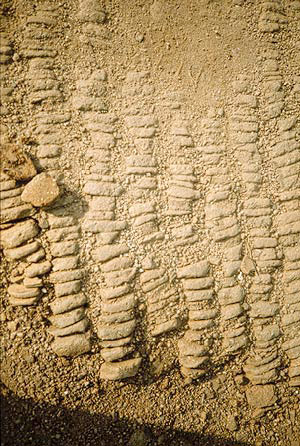 How the pavements were created, according to oral tradition: http://books.google.com/books?id=-U70Ts7CgEYC&pg=PA85&lpg=PA85&dq=luwo+ooni+pavement+ife&source=bl&ots=TG6YGYhXxw&sig=c2c6mmXPKy01-kmnO0xmVSJVfuU&hl=en&ei=IFaSTonjIu_HsQKNtqyeAQ&sa=X&oi=book_result&ct=result&resnum=1&ved=0CB4Q6AEwAA#v=onepage&q=luwo%20ooni%20pavement%20ife&f=false |
Bet you didn't know that they danced to Soukous in South America. It's called "Champeta" in Colombia. [flash=500,400] https://www.youtube.com/watch?v=n1QAdX6Si0Q[/flash] |
The African influence is intense in Cuba. They drum bata and even still sing in Yoruba! [flash=500,400] https://www.youtube.com/watch?v=o3QwwhsAPEg&feature=related[/flash] |
One of the most "African" latin dances-- this one is straight African. Colombian "Mapale" [flash=500,400] https://www.youtube.com/watch?v=5oipqt8-dOM[/flash] |
^^ Katunga is in Oyo state. It is now known as Oyo-Ile. The former capital is surrounded by a national park -- Old Oyo National Park. |
Read more about how Frobenius knew where to dig -- he simply asked the people of Ife! http://books.google.com/books?id=z8Ef3NpQKyUC&pg=PA189&lpg=PA189&dq=ile+ife+bronzes+buried+rulers&source=bl&ots=Sc1AgRzd_E&sig=h66Ou5ulVr_-A-YsMkdC3DrSrKQ&hl=en&ei=SX6KTqL4FIT40gGQ19yDBQ&sa=X&oi=book_result&ct=result&resnum=3&ved=0CDIQ6AEwAg#v=onepage&q&f=false |
tpia@: The Ife sculptures are a mystery. I often wonder if the earliest of the bronzes occurred during the lifetime of Oduduwa (if he was a real person). Frobenius getting credit for "discovering" the bronzes is once again European chauvinism. He heard about the bronzes from the Yoruba people, and knew where he was digging for the "Olokun" head -- he paid the guardian of the Olokun shrine money to dig up the head. 1 Like 1 Share |
 A rare early C20th image of Yoruba women dyers with their clay dye pots. Vintage postcard, circa 1910, authors collection. (As mentioned before) Indigo was the foundation of numerous textile traditions throughout West Africa. For centuries before the introduction of synthetic dyes the ability to transform everyday white cotton into prized deep blue cloth was a mysterious and highly valuable skill passed on by specialist dyers from generation to generation. From the Tuareg nomads of the Sahara to the grassland kingdoms of Cameroon, indigo cloth signified wealth, abundance and fertility. Appropriately it was women who dyed cloth with indigo in most areas, with the Yoruba of Nigeria and the Manding of Mali (especially the Soninke /Malinke) particularly well known for their expertise. Yoruba dyers paid tribute to a patron deity, Iya Mapo to ensure the success of the complex dye process. |
BODY ART: As much as Yoruba people of today are (unfairly lol) "marked" as people who perpetuate tribal markings, some of the old school tribal marks/tattoos were rather interesting. 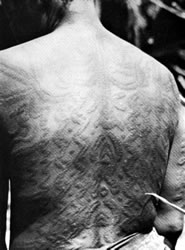 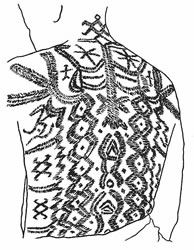 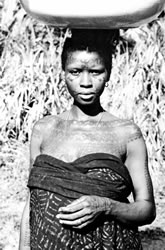 |
(1) (2) (3) (4) (5) (6) (7) (8) (9) (10) (of 12 pages)
(Go Up)
| Sections: politics (1) business autos (1) jobs (1) career education (1) romance computers phones travel sports fashion health religion celebs tv-movies music-radio literature webmasters programming techmarket Links: (1) (2) (3) (4) (5) (6) (7) (8) (9) (10) Nairaland - Copyright © 2005 - 2024 Oluwaseun Osewa. All rights reserved. See How To Advertise. 55 |
